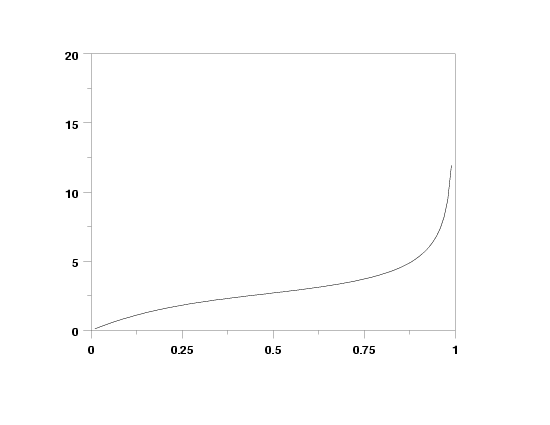

|
WAKPPFName:

where U is a standard uniform random variable. That is, the above equation defines the percent point function for the Wakeby distribution.
The parameters
The following restrictions apply to the parameters of this distribution:
The domain of the Wakeby distribution is
With three shape parameters, the Wakeby distribution can model a wide variety of shapes.
<SUBSET/EXCEPT/FOR qualification> where <p> is a number, parameter, or variable in the interval (0,1); <y> is a variable or a parameter (depending on what <p> is) where the computed Wakeby ppf value is stored; <beta> is a number, parameter, or variable that specifies the first shape parameter; <gamma> is a number, parameter, or variable that specifies the second shape parameter; <delta> is a number, parameter, or variable that specifies the third shape parameter; <chi> is a number, parameter, or variable that specifies the location parameter; <alpha> is a number, parameter, or variable that specifies the scale parameter; and where the <SUBSET/EXCEPT/FOR qualification> is optional. If <xi> and <alpha> are omitted, they default to 0 and 1, respectively.
LET A = WAKPPF(13,2.5,6,0,10) PLOT WAKPPF(X,2.5,6) FOR X = -10 0.1 10
Hoskings report and associated Fortran code can be downloaded from the Statlib archive at
J. R. M. Hosking (2000), "Research Report: Fortran Routines for use with the Method of L-Moments", IBM Research Division, T. J. Watson Research Center, Yorktown Heights, NY 10598. Hoskings (1990), "L-moments: Analysis and Estimation of Distribution using Linear Combinations of Order Statistics", Journal of the Royal Statistical Society, Series B, 52, pp. 105-124.
let xi = 0
let alpha = 10
let beta = 5
let gamma = 1
let delta = 0.3
.
plot wakppf(p,beta,gamma,delta,xi,alpha) for p = 0.01 0.01 0.99

Date created: 12/17/2007 |